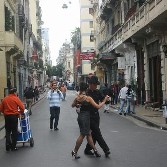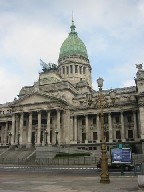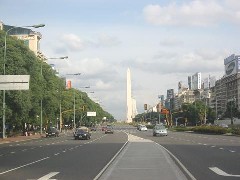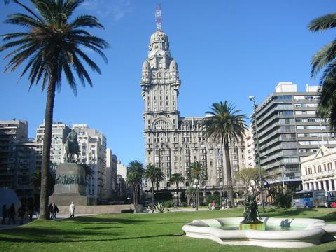By Lawrence Selby – Guest blogger traveling in Montevideo.
In a previous blog entry, I talked a bit about the Ciudad Vieja. Some areas are completely renovated and gentrified. In other areas, the buildings are still completely blown out and abandoned. In between, there's a sort of ghetto "fringe" area. The police were located on the border of the "fringe" area and a blown out section of the old city. The police station occupied the ground floor of a very old and shabby looking row house. We spent the next several hours talking with the police and filling out paperwork about the incident. During the ordeal, a few girls arrived at the station. Ladrones (thieves) had apparently snatched the purse of a pretty girl while she was walking in the Plaza Independencia. Meanwhile, Enrique was pestering me to talk with the girls. "Don't let them go! Talk to them in English. Ask for their phone numbers!" he said. Meanwhile, I'm practically falling asleep on my feet. It was 4 am when we finished at the police station and walked to the public hospital.
The public hospital was only a few blocks away from the police station, though not in the direction of the gentrified area. It seemed to be located in the middle of an abandoned part of the city. The public health care system here is, I'm told, free. Unfortunately, the hospital (or maybe clinic is a better word) that I saw was not a place where most people would want to spend much time unless they were in dire straits. The building was gloomy and depressing and smelled sharply of disinfectant. I saw a few wheelchairs that looked like they had been salvaged from a junk yard. The waiting room was packed with people sleeping on benches and some homeless people on the floor. Uruguay doesn't have a large black population though the majority of the patients here were black or mestizo (mixed black and European background).
It was around 5:30 am by the time that we finished there and the doctors at the clinic had a chance to take a quick look at Adrian's head and Enrique's eye. They handed them a few papers and gave them a pat on the back.
By this time I'm completely exhausted and understanding and speaking no Spanish at all. Enrique meanwhile, is ready to hit another club. "The clubs don't close until 7 am!" he says. I ask him what time he woke up and tells me around 4 pm the previous afternoon. In need of a serious caffeine infusion, we walk to the Plaza Independencia and go to a restaurant for pizza and coffee. While in the restaurant, Enrique asks if we should go to a club in Pocitos or back to the Ciudad Vieja the next day. I nod my head, yes. The evening mercifully ends after I catch a taxi and make it back home at around 7 am.
Things could definitely have been worse.
Martial Arts Worldwide
By Alexa Boyce
When people here in the States think of Martial Arts, they may think of Bruce Lee's street fighting technique or Mr. Miyagi's disciplined approach. The truth is, that martial arts come in a large variety of styles and emphases. Some martial arts styles stress street combat, others stress sports skills and competition, others stress internal energy or chi, while still others are traditional arts that stress perfection of technique, self discipline and etiquette. They also vary in the main body stances, and can be divided into Stand-Up Style, Ground Fighting/Grappling Style, Throwing Style, Weapons- Based Style and Low-Impact or Meditative Style. Below, you will find a list of various martial arts practices and their unique features.
Karate:
This Stand-Up Style martial art is traditionally considered to have originated in Okinawa, Japan, though it actually originated in China. Karate emphasizes power through various stances and footwork. Karate is practiced in stylized routines.
Kung Fu:
Another Stand-Up style, Kung Fu originated in China, Tibet and Mongolia. The words Kung Fu literally mean “hard work” or specifically, skill achieved through hard work. There are more than 400 different sub-styles of Kung Fu, and can stress skills such as stances or hand techniques.
Tai Kwon Do:
This Stand-Up style originated in Korea during the Koguryo dynasty, though modern TKD was developed in the 40's during the Japanese occupation, and bears little resemblance to the traditional TKD. Modern TKD emphasizes kicks and sparring, punches to the head are not allowed.
Brazilian Jiu Jitsu
This Grappling style originated in Japan, and was brought to Brazil in the early 20th century when Jiu Jitsu master Mitsuo Maeda emigrated from Japan. Brazilians honed this art through street fights until it became the completely unique art that it is today.
Capoeira:
An Afro-Brazilian martial art whose influence can be most seen in Northern Brazil, in places such as Salvador. This style is heavily influenced by dance, and is always performed to music. Characteristics are deft, tricky moves played on the ground or completely inverted. It is very acrobatic and fun to watch as well as do.
Krav Maga:
In Hebrew, Krav Maga means “close combat”. It is a self-defense and military hand-to-hand combat technique. It is popular among civilians as well, though civilian classes generally leave out the killing techniques taught to the military and the hold stances taught to Israeli police.
Tai Chi:
This Meditative style art originated in China in the 15th and 16th centuries. For the most part, Tai Chi is a slow moving style that stresses breathing techniques to facilitate the flow of chi. Broken up into Yang, Chen, Wu, and Sun styles.
Japan Goes Pop
By Kayla Allen
For years Japanese pop art has been popular and recognizable worldwide but in recent years with video games and anime becoming more like moving masterpieces and just as suitable for adults as children, Japanese pop art has become more pervasive than ever.
From fine art to manga (Japanese comic books), to the stationary you write your letters on, Japanese pop images and icons are everywhere.
Even with its international growth, nowhere is Japanese pop art more popular than in Japan. Manga crosses all parts of society and age groups with themes and images to entertain and attract all its audience members. In Japan it is not uncommon to see a business man reading a manga at lunch in a restaurant or a woman reading a romance manga on the bus.
Though Japanese pop hasn't reached those proportions in the states yet, when I look around my house, I have to say, we may just get there.
My refridgerator and home are covered in Nara. An artist with his beginnings in manga, Yoshitomo Nara has taken a huge role in American pop culture, art culture and my home. You can walk into both popular clothing stores and popular art galleries in the states and see his images. His reach is widespread and I hope it only grows.
While I'm not a big video game fan, when I saw how fun Katamari Domacy is, it became the first video game that I've purchased as an adult. Designed by a starving Japanese artist who had to go to work for a big company to pay the bills, he said his intentions in designing this game were to make people happy. It's done just that with hysterical imagery and happy inducing music to boot.
When manga met America's hardcore comic fans it instantly gained popularity and a permanent rapt audience. And although our market for manga may never quite reach that of Japan's, anime is now a mainstay for television before and after school and on Saturday mornings as well. So with millions of children growing up with these images I'm wagering Japanese pop is here to stay.
Train Wreck – In Montevideo
By Lawrence Selby – Guest blogger traveling in Montevideo.
The plan for Friday night was another late night excursion into the Ciudad Vieja with Adrian, the school tour guide and ambassador. This time the group was much smaller; it was just Adrian, his girlfriend Daniela, Enrique (a former student at the school) and myself. The evening had bad karma from the start. Daniela was in a foul mood and was insanely jealous every time that Adrian would look in the direction of another girl. There were girls and guys handing out pamphlets for clubs nearby. On several occasions, I saw Daniela snatch the pamphlets from Adrian's hand on throw them on the ground. We walked back and forth across the streets of the Ciudad Vieja while the two of them argued about which club to go to. Needless to say, no one was having a good time and I was feeling stupid for traveling half way around the world to be in such a ridiculous situation. "This is a train wreck," I told Enrique, and we both agreed to "lose" ourselves if we didn't settle on a place to go in the next 5 minutes.
Adrian and Daniela finally agreed on a club called Ciudad V and we were sitting down at a table drinking beer. Enrique was goading me into talking to a couple of girls sitting behind us. "You've got the accent," he said. "I don't have an accent," I told him, "its more like I have no Spanish." As I was thinking about the first few sentences of a possible conversation in Spanish, I was stunned by a loud noise like a bomb going off and glass shattering. Beer and glass fragments went flying everywhere. When I recovered from the shock a few moments later, I realized that a glass disco ball hanging from the ceiling had fallen. After striking Adrian in the head, the ball landing in the middle of the table in between us and shattered, along with the beer bottles and glasses. It turned out that no one was badly injured. Adrian had a nasty bump on his head and a few scratches. Enrique had some glass in his face and was worried about some glass near his eye. I had a few scratches on my face. And, of course Adrian, Enrique and I were drenched in beer and glass. As luck would have it, all the beer and glass somehow miraculously missed Daniela. When we talked to the owner he flatly denied any responsibility for the accident and even refused to refund the club entrance fees that we paid. Adrian was furious and told the owner that we were going to the police. We hailed a taxi outside the club and went to the police station. It was around 2 am at this time.
Chinese Zodiac
By Alexa Boyce

The Chinese zodiac is a form of astrology based on the Chinese calendar, a 12-year cycle of animals. Ancient Chinese astrologers called the five major planets by the name of the element that it was associated with. Venus corresponds to Metal (gold); Jupiter to Wood; Mercury to Water; Mars to Fire; Saturn to Earth. It is said that the position of these planets, along with the positions of the Sun, Moon, any comets in the sky as well as time of birth and Zodiac Sign can determine a person's destiny according to Chinese Astrology.
Chinese astrology is different from Western astrology because while there are eighty eight constellations named in Western astrology, the Chinese have only twenty eight. In the fortune telling system, There is a binary Yin Yang cycle, which enlarges the five element cycle to a cycle of 10 (seen below). Even years are yang, odd years are yin. Since the zodiac animal cycle of 12 is divisible by two, every zodiac can only occur in either yin or yang: the dragon is always yang, the snake is always yin, etc. This combination creates a 60-year cycle, starting with Wood Rat and ending with Water Pig. The current cycle began in the year 1984.
Many fairy tales and myths are associated with the stars and the telling of Chinese fortunes. Many legends exist to explain the beginning of the zodiac. One of the more popular ones explains why the cat is not one of the zodiac animals. It says that the Jade Emperor holds a royal banquet to select animals, but the Rat tricks the Cat into believing the banquet is the day after it actually is. When the Cat finds this out, he vows to be the Rat's natural enemy for ages to come.
My Home is Wherever I am
By Lawrence Selby – Guest blogger traveling in Montevideo.
I went to the Teatro Solis for a concert tonight on an excursion with the school. The Teatro Solis is one of the premier music theaters in Latin America, so I definitely didn't want to miss the opportunity. The big event also had the unexpected side benefit of drawing out all the other current students at the school: Lorenzo (or Lorenzo Numero Dos as he is sometimes referred to) a new Swiss German student, Anna from Holland, and Daphna an Israeli American.
The concert was violin and piano pieces by Mozart and Shostakovich which I thought was an odd combination, though I did enjoy the music and the experience of being in a grand theater again quite a bit. The Teatro Solis itself is a beautiful building. It reminds me a little of Lincoln Center in New York City only much smaller and more intimate.
After the concert Adrian, Anna, Daphna and I went into the Cuidad Vieja in search of a cafe for coffee and dessert. Strangely, Lorenzo Numero Dos wandered off abruptly after the concert performance muttering, terminar, terminar … He doesn't speak much English or Spanish unfortunately. The Cuidad Vieja was beautiful at night and we found a nice outdoor cafe on
Sarandi Calle (the main street in the Ciedad Vieja). Without doubt one of the best things about traveling is that you get the chance to meet some of the most fascinating people. Daphna semi-retired and a self proclaimed gypsy who feels she may have finally found a home at long last in Montevideo. Anna is another free wheeling, bohemian sort of person. She started studying Spanish in Montevideo in November and recently returned from a volunteer project at an orphanage in Cordoba, Argentina. We had a long conversation that spanned many topics including: life in Montevideo, learning new languages, how to meet people when you move to a new city, making and losing a fortune, failed marriages (Daphna had 4) and relationships, life in an Israeli kibitz, and winter in Siberia. They both agreed about something that immediately struck me as profound. "My home is wherever I am," Daphna said. This made me think of something that Alan Alda once said, "Be brave enough to live life creatively. The creative place is where no one else has ever been."
Later this month, Anna is going to pack up again and live in Vienna, Austria with her boyfriend (whom she met a few months ago here in Montevideo). She is looking forward to learning the tango and the Viennese waltz with him. Daphna recently had all her things shipped to Montevideo and is renting a great apartment in the Ciudad Vieja for $300 a month. She feels that she is living her life backwards. And for an encore, I am going … where? Maybe I'll go home.
Buenos Aires – Continued
By Lawrence Selby – Guest blogger traveling in Montevideo.
I never did find Evita's grave. After two days of aimless wandering around Buenos Aires, I ended up more or less by chance in the splendid but eerie La Recoleta cemetery in the Barrio Norte. It's a beautiful place, though perhaps beautiful is not the best word to describe the cemetery; it's stately, peaceful and somber. The cemetery is a mazelike park with rows of grand ornate tombs and sepulchers. There are many cats prowling around the great tombs where a number of the prominent historical Argentineans and their families are apparently buried. Being the ignorant American that I am (or estadounidense to be more precise) the only historical Argentine that I know of are Evita and Juan Peron and Maradona, of course (though he's not dead yet). There are no special signposts to her grave so it's not easy to find. I couldn't help but think that perhaps the Portenos (the people of Buenos Aires) don't want to celebrate Evita's notoriety at the expense of other more worthy people and families from Argentina's past?

Buenos Aires is a great city for wandering. I didn't use public transportation or taxis, preferring to walk instead. Though I did miss some of the prominent sights and barrios such as the wealthy Palermo district (to the north) and the famous La Boca barrio (to the south), I was able to cover a lot of ground and see much of the city and many of the tourist areas. The city center where is stayed is home to many of the historical monuments, theaters and grand boulevards. Calle Florida (discussed in the previous blog entry) is also in the central district and a main pedestrian thoroughfare and shopping area. The barrios to the north tend to be more upscale and largely residential. Retiro and Recoleta (where the cemetery is) are two of the northern barrios within striking distance from the city center. The southern barrios, such as Montserrat and San Telmo, are more historical, colorful and seedier. I believe that San Telmo is home to the tango, as there were many street performers, exhibitions and seemingly all things tango in that barrio. I won't even try to discuss all the prominent buildings, churches and monuments as I didn't really know the historical significance of most of them (this really was a whirlwind tour) and the photos will do them much better justice (I hope). Suffice to say that Buenos Aires is a great city and the look and feel of the city and its people is very European.
I don't want to paint a picture of Buenos Aires as paradise on earth, though. I did see obvious signs of the economic meltdown that the country went through recently. I saw quite a few homeless people and stray dogs on the streets. In some parts of the city center and San Telmo it was impossible to walk 50 feet without being handed leaflets and/or being asked for money. This is despite the fact that I tried not to attract much attention and am sure that I don't stand out as an obvious tourist. There was quite a lot of graffiti around and some of the grand buildings seemed a bit run down (including the Parliament). Walking around the different neighborhoods, the disparity between the haves and the have-nots was not difficult to notice. In all fairness though, these observations could be made about almost any other large city in the world. I would love to go back again someday with some friends and walk around a little less and enjoy the city a lot more.
Egypt Arabic
By Alexa Boyce
There is usually a local dialect associated with each country or region, but that of Egypt is understood universally in the Arabic world. This is due to the large number of movies and television shows that are filmed in Cairo. In fact, Cairo boasts the third largest film industry aside from Hollywood here in the United States and Bollywood in India.
Some countries caught on more quickly than others to the advent of cinema in the early twentieth century. Egypt was one of those countries. By 1917 there were 80 movie theaters in the country. "Laila" by Stephen Rosti, widely considered to be the first 'Egyptian' film, was released in 1927. When sound was introduced in the 1930s, this new media really took off.
Today, there is an ongoing struggle between conservative Muslim censorship and the liberal media. This website has some really good articles on both the history and modern state of Egyptian cinema.
Buenos Aires – First Impressions
By Lawrence Selby - Guest blogger traveling in Montevideo.

It's Friday night at 11:30 pm and I'm in my hotel room in Buenos Aires. The Rough Guide says, ¨There's no excuse for staying in on any night in Buenos Aires.¨ And though I've only been here a few hours, from what I've seen of the city so far, I can understand why. But, it's been a long day, I'm tired and I've got a lot of exploring to do tomorrow. I need to wake up bright and early in the morning.
Travel from Montevideo to Buenos Aires consists of a two hour bus ride from Montevideo to Colonia (in Uruguay across the river from Buenos Aires), an hour layover in the ferry terminal, then another hour long ferry ride to Buenos Aires. The bus and ferry service from Montevideo was relatively uneventful except for a screw-up at the border immigrations in Colonia that rattled me a bit.
During the ride from Montevideo, I had been chatting with an elderly lady on the bus and starting to feel pretty decent about my new linguistic abilities. When I got to immigrations in Colonia, I realized that I had lost my Uruguay port arrival papers (or whatever the immigrations form is called) that I had gotten 2 weeks ago when I had entered the country. Immigrations sent me to talk to a supervisor there and he started blasting all sorts of questions at me in Spanish. This left me tongue tied and destroyed any residual good feelings that I had about my ability to communicate effectively. Eventually, the paperwork got worked out though I was stressed because: (1) I was in a hurry to settle the problems so that I could catch the ferry in time, (2) my bag was left near the counter of the immigrations booth while I was in the office talking to the supervisor (I don't like to leave my things much farther than hands reach away when traveling). They also charged me U$S 17, which may not sound like a lot of money but in Uruguayan pesos this amounts to the cost of a night out on the town. After I boarded the ferry, I realized that I had left my jacket somewhere in all of the shuffle. I was rather annoyed at first, but got over it quickly. At that point there was really no use worrying about it.
During the quick shuttle ride from the Buquebus terminal to my hotel, I was pretty impressed with what I was of Buenos Aires: sleek modern high rise buildings, glimpses of grand sweeping boulevards, and European style pedestrian shopping thoroughfares teeming with people. I made it to my hotel room at around 8:30 pm and was tempted to just pack it in for the night but decided to walk around a bit and see more of the central district at night. I'm glad that I did.
The city center definitely has a very European look and feel, perhaps more so than anywhere else that I've been to in the Americas (as I'm writing this I'm also thinking that the mall and surrounding areas of NW Washington D.C have a European feel as well).
Before I left, my professor in Montevideo told me that Avenida 9 de Julio is approximately 300 meters wide and is supposedly the widest boulevard in the world. Whether or not that's true, Av 9 de Julio is enormous. At the point that I crossed it (at Cordoba and Av 9 de Julio), I counted 9 car lanes with a large divider in each direction, and a larger park like divider in the middle. There's also a grand obelisk monument in the middle of Av 9 de Julio at Av Corrientes that looks like a spitting image of the Washington monument in Washington D.C. At first I wondered if one of them was some sort of knockoff of the other, then realized that if anyone invented the obelisk it would have to have been the Egyptians. On one pedestrian street (Av Florida I think?) I saw a street performer dressed up like Michael Jackson doing a choreographed dance routine with a very passable impression and likeness. I have to give the guy credit for being good, but who would want to impersonate Michael Jackson? Maybe Michael Jackson doesn't have the same stigma here that he does in the States?

Like all great cities there is a palpable sense of energy and electricity in the air. If I had some of my amigos with me from home, I'm sure that I'd still be out there. If my friend Andy from Virginia Beach was here, we'd probably end up in an Irish pub at 4 am. I don't know if Buenos Aires (or South America for that matter) has many Irish pubs, but I'd guess it's a pretty safe bet that we could find one. Irish pubs seem to be about as ubiquitous as McDonalds.
Exploring Montevideo
By Lawrence Selby - Guest blogger traveling in Montevideo.

It's always been my opinion that the best way to get to know a city is simply to walk around a lot and take a look. I'm well into my second week now, so I've had plenty of opportunities to explore the city. I try to take long walks at least every other day; it's a great way to relax and get a bit of exercise. The more that I come to know this place, I'm inclined to agree with what the Rough Guide said. Montevideo is a thoroughly likeable small city that is easy to get a feel for. It's also a bit eclectic and strange in a nice sort of way.
From tourist standpoint, the major thoroughfare is La Rambla. La Rambla is a boulevard along the Rio de la Plata which runs roughly west to east for about 15 km from the Ciudad Vieja (old city) to the wealthier outskirts of the city along the beach at Carrasco (near the airport). La Rambla has many names. Every km or so the name changes. Some of the names that I've seen include: Rbla Francia, Rbla Armenia, Rbla President Wilson, Rbla Mahatma Gandhi, … I'm sure that there's a reason that they chose these names and this scheme though it does strike me as a bit strange.
There are many statues and monuments along La Rambla and the surrounding areas. Again, there doesn't seem to be too much of a pattern. I saw a monument dedicated to Confucius, another to some sort of Neptune goddess, and a Jewish holocaust memorial (which in itself isn't strange, but the monument is rather bizarre). I also saw a bronze statue dedicated to some guy with a Spanish name that lived approximately 100 years ago. This last statue probably made the most sense to me. There are beaches along many stretches of La Rambla and also a small harbor, soccer fields, parks and the occasional restaurant or cafe. Every time that I've seen it, the water has always been a sort of light chocolate brown color, though I'm told that this does change at times.
People tell me that this is because of the silt runoff upstream and not pollution. There is some graffiti in spots and the infrastructure and surrounding buildings are a bit run down in places.
It doesn't seem dangerous, though. I'm told Montevideo has one of the highest per capita police forces in the world. When the weather is nice, there's always a small crowd relaxing and strolling along La Rambla in Pocitos (one of the wealthier barrios about 5+ km from the Ciudad Vieja).
The Ciudad Vieja is probably the top tourist attraction in Montevideo. It's a small area (probably one km square) located between the old port and El Centro barrio. As the name implies, the Ciudad Vieja is the original Montevideo and is composed of Spanish style antique row houses. There are a few pretty squares and (of course) more statues and monuments.
Most of the statues in this area are more traditional, usually a man on a horse with a sword drawn (or with some similar pose). As I wandered into the area, I felt a comfortable feeling of recognition with the energy and vibe. For lack of better words, it seems a little bit like the West Village (in New York City) with the old buildings and architecture of Seville, Spain. The thing that I found most interesting about the place (and maybe I'm a bit strange for feeling this way) is that the restoration of the Ciudad Vieja is probably about 50% complete at best. Sometimes when you stand at an intersection and look a block down the road you can see blocks of gutted and completely abandoned old ornate Spanish row houses.
So, within one glance you can see the buildings in all the various states of repair: blown out, partially repaired and completely restored. To me this contrast lends a feeling of authenticity about the place that I wouldn't have felt if it were completely gentrified. There are ¨For Sale¨ signs on many of the fringe row houses; I'm sure Donald Trump would be salivating.



 ShareThis
ShareThis
